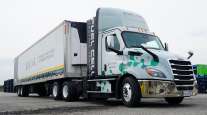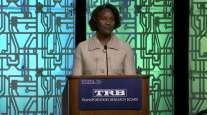Staff Reporter
Truck Freight Routes Could Be Hydrogen Fueling Station Backbone

[Stay on top of transportation news: Get TTNews in your inbox.]
WASHINGTON — California fuel cell advocates are urging a national strategy to replace diesel-powered heavy trucks at major U.S. ports and link future regional hydrogen hubs to create a fueling infrastructure.
That scenario was revealed by Bill Elrick, executive director of the California-government-backed Hydrogen Fuel Cell Partnership, who led a session called “Heavy-Duty Implementation for Electric and Hydrogen Fuel Cell Vehicles” at the Transportation Research Board Annual Meeting on Jan. 9.
“We can’t stop at the border of California,” Elrick said, noting that the truck market needs a national hydrogen mobility strategy and an interconnected U.S. infrastructure that links hydrogen refueling stations.
Such a strategy would be a remedy for the lack of hydrogen refueling infrastructure, which is presenting a challenge in getting more fuel cell trucks on the road, he noted.
Hydrogen Fuel Cell Partnership
Founded in 1999 as the California Fuel Cell Partnership, the government-private group's goal is to increase the market for fuel cell electric vehicles powered by hydrogen for zero-emission vehicles.
Member organizations include:
- California Air Resources Board
- Cities of Lancaster and San Francisco
- Office of Gov. Gavin Newsom
- U.S. Department of Energy
- Environmental Protection Agency
- Daimler Truck
- Cummins
- Toyota,
- Shell Hydrogen
- Phillips 66
- SiriusXM
- SoCalGas
Electric battery vehicles relying on the electricity grid and fuel cell vehicles fueled by hydrogen are needed “to take the combustion system out of the equation,” Elrick said. “It’s not an either or, it’s both.”
Essential elements in a national hydrogen strategy initially would use cross-country truck freight routes, starting at major ports, to create an “infrastructure backbone” for heavy-duty fuel cell vehicles, with light-duty fuel cell consumer market focused in urban areas.

Elrick
“The Toyota-Port of Los Angeles demonstration project proved, one for one, these trucks can really replace the diesel counterparts,” Elrick said, adding that the hydrogen option “is really is proving everything we want to prove in its early days.”
In September, Toyota Motor North America announced the successful demonstration of its project with Kenworth Truck Co. on jointly designed Class 8 fuel cell trucks as potential replacements for diesel-powered drayage trucks. The experimental fuel cell trucks completed the Zero- and Near-Zero Emissions Freight Facilities “Shore to Store” pilot project at the Port of Los Angeles, the Los Angeles basin and Inland Empire.

What is the outlook for trucking in 2023? How will the industry change with the current government, economic and business trends? Join host Michael Freeze and TT reporters Eugene Mulero and Connor Wolf. Hear the program above and at RoadSigns.TTNews.com.
The project used 10 fuel cell trucks (against a 2017 diesel model operating 200 miles daily) with an individual 300-mile range when fully loaded to 82,000 pounds. Results indicated the fuel cell trucks could run multiple shifts daily up to 400 and 500 miles without downtime between shifts for charging and had 15- to 20-minute fill times.
Kenworth designed and built the trucks, while Toyota was responsible for creating the powertrain’s fuel cell electric power system that used hydrogen. It is estimated the fuel cell trucks reduced greenhouse gases by 74.66 metric tons of carbon dioxide per truck annually compared with a baseline diesel engine.
Elrick called hydrogen-powered fuel cell heavy duty trucks a great replacement option for diesel trucks because the refueling behavior is the same: drive into a station, swipe a card, pull a nozzle.
Other states can benefit with lessons learned in California since it leads the nation in developing fuel cell vehicles, he said.
Want more news? Listen to today's daily briefing above or go here for more info
Creating a national hydrogen mobility strategy would establish a central vision with clear objectives: improve communications among stakeholders, coordinate stakeholder investments to ensure a sustainable market and meet economic objectives for all.
Key partners in a national strategy would be regional hydrogen hubs that are being proposed to DOE.
Elrick discussed creating a freight movement vision in California and beyond with market conditions to support 200 hydrogen fueling stations for 70,000 fuel cell heavy duty trucks. This scenario would displace 541.8 million gallons of diesel annually and avoid releasing 18,100 metric tons of nitrogen oxide and 6.7 million metric tons of greenhouse gases yearly.
He cited a CARB light-duty fuel cell vehicle study showing that hydrogen fuel stations and fuel cell electric vehicle deployments have to grow together to achieve full benefits.
“Hydrogen trucks are coming very fast. California regulations are pushing them even harder,” he said. “Private industry has to be there to support it.”




